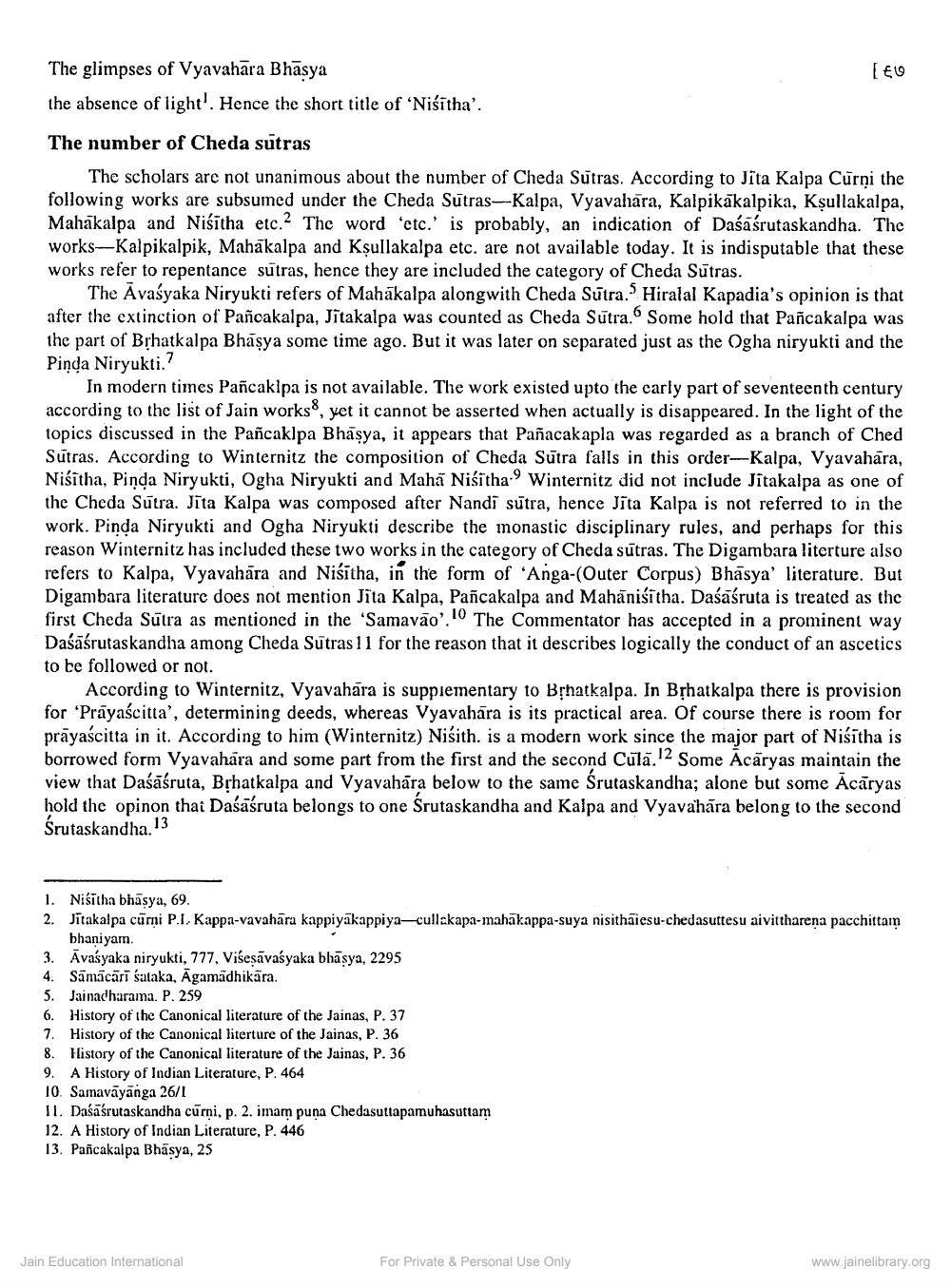________________
[EU
The glimpses of Vyavahāra Bhasya the absence of light'. Hence the short title of Niśitha'.
The number of Cheda sutras
The scholars are not unanimous about the number of Cheda Sutras. According to Jita Kalpa Curņi the following works are subsumed under the Cheda Sutras-Kalpa, Vyavahāra, Kalpikakalpika, Kșullakalpa, Mahakalpa and Niśitha etc. The word 'etc.' is probably, an indication of Daśaśrutaskandha. The works—Kalpikalpik, Mahākalpa and Kșullakalpa etc. are not available today. It is indisputable that these works refer to repentance sutras, hence they are included the category of Cheda Sūtras.
The Avaśyaka Niryukti refers of Mahākalpa alongwith Cheda Sūtra. Hiralal Kapadia's opinion is that after the extinction of Pañcakalpa, Jitakalpa was counted as Cheda Sūtra. Some hold that Pancakalpa was the part of Brhatkalpa Bhasya some time ago. But it was later on separated just as the Ogha niryukti and the Pinda Niryukti.?
In modern times Pañcaklpa is not available. The work existed upto the carly part of seventeenth century according to the list of Jain works, yet it cannot be asserted when actually is disappeared. In the light of the topics discussed in the Pañcaklpa Bhasya, it appears that Pañacakapla was regarded as a branch of Ched Sūtras. According to Winternitz the composition of Cheda Sūtra falls in this order--Kalpa, Vyavahara, Niśītha, Pinda Niryukti, Ogha Niryukti and Maha Niśitha: Winternitz did not include Jitakalpa as one of the Cheda Sutra. Jīta Kalpa was composed after Nandi sutra, hence Jīta Kalpa is not referred to in the work. Pinda Niryukti and Ogha Niryukti describe the monastic disciplinary rules, and perhaps for this reason Winternitz has included these two works in the category of Cheda sutras. The Digambara literture also refers to Kalpa, Vyavahāra and Niśitha, in the form of 'Anga-(Outer Corpus) Bhasya' literature. But Digambara literature does not mention Jīta Kalpa, Pancakalpa and Mahānisitha. Daśāśruta is treated as the first Cheda Sūtra as mentioned in the 'Samavão.10 The Commentator has accepted in a prominent way Daśāśrutaskandha among Cheda Sūtras 11 for the reason that it describes logically the conduct of an ascetics to be followed or not.
According to Winternitz, Vyavahāra is supplementary to Brhatkalpa. In Brhatkalpa there is provision for 'Prāyaścitta', determining deeds, whereas Vyavahāra is its practical area. Of course there is room for prāyascitta in it. According to him (Winternitz) Niśith. is a modern work since the major part of Niśītha is borrowed form Vyavahara and some part from the first and the second Cula.l2 Some Acāryas maintain the view that Daśāśruta, Běhatkalpa and Vyavahāra below to the same Śrutaskandha; alone but some Acāryas hold the opinon that Daśāśruta belongs to one Śrutaskandha and Kalpa and Vyavahāra belong to the second Śrutaskandha. 13
1. Niśitha bhāsya, 69. 2. Jitakalpa cūrni P.1. Kappa-vavahāra kappiyakappiya—cullckapa-mahakappa-suya nisithāiesu-chedasuttesu aivittharena pacchittam
bhaniyam. 3. Āvasyaka niryukti, 777, Viseşāvaśyaka bhāsya, 2295 4. Sāmācāri salaka, Agamadhikara. 5. Jainadharama. P. 259 6. History of the Canonical literature of the Jainas, P. 37 7. History of the Canonical literture of the Jainas, P. 36 8. History of the Canonical literature of the Jainas, P. 36 9. A History of Indian Literature, P. 464 10. Samavāyanga 26/1 11. Daśāśrutaskandha cūrni, p. 2. imam puna Chedasuttapamuhasuttam 12. A History of Indian Literature, P. 446 13. Pancakalpa Bhäsya, 25
Jain Education International
For Private & Personal Use Only
www.jainelibrary.org




